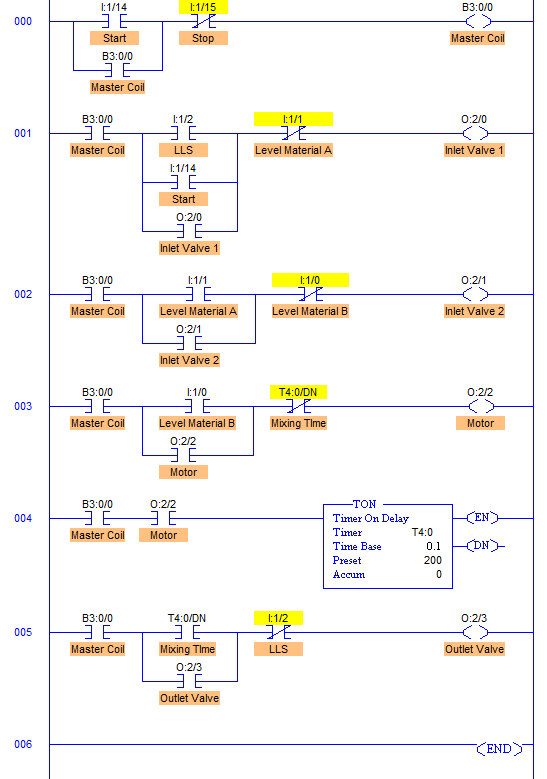Simple Plc Programs Examples


Examples Please click on an example that interest you to navigate there. Say when you press a button, your PLC will greet you either 'Good Morning', 'Good Afternoon' or 'Good Evening' on its LCD display depending on the time of the day.
Basic PLC Ladder Programming Training Examples for Beginners. Hi friends here we are starting here a series of Free Training on PLC Ladder Programming training & tutorials.These PLC Ladder Programs are important to get basics of Ladder programs. Simple Ladder Logic Primary Programming Language for PLCs. Example 1 Computer Aided. (PLC Memory) Ladder Logic Program Runs Output Image (PLC. Basic PLC Ladder Programming Training Examples for Beginners. Hi friends here we are starting here a series of Free Training on PLC Ladder Programming training.
1) Create a ladder logic circuit, with an input contact named 'Greetings', and use it to trigger a custom function #10 when the button connected to this input is pressed. Note: Circuit #1 shown below is a standard ladder 'seal' circuit which turns on the output 'Run' whenever the input 'Start' is closed momentarily.
The 'Run' output will only be turned OFF when the NC 'Stop' input is energized. In Circuit #2, both the 'Run' bit and 'Greetings' input must be closed to trigger the Custom Function #10.
The Custom Function #10 is 'differentiated' (aka 'one-shot') type which means that it will execute only once when triggered 2) Next, edit the custom function #10 and enter the following TBASIC program code: That's all! Note: You only need to use the BASIC language as and when needed as demonstrated in the above case. Otherwise, the PLC will happily execute standard ladder logic circuit based on AND, OR, NOT, timers, counters only! Create your own Digital Tachometer: Monitor the frequency of incoming pulses and display the reading on an LCD display This is unbelievably easy to achieve with Ladder+BASIC language!
Download Megaman X6 Rom Psx Roms Deutsch. As you can see below, the whole program comprises just one ladder logic rung and one custom function: The ladder rung uses a built-in 'clock pulse' to trigger the function #1 every 0.2s. The content of Fn_#1 is displayed to the right. The moment a pulse frequency measurement channel is enabled by the 'PMON' command, you can use the built-in 'PULSEFREQUENCY(1)' command to obtain the frequency value in Hz. The 'SETLCD' command is used to display the data and text on the LCD.
Every 0.5s, measure the signal at Analog Input #1 and then format the reading into ASCII string as 'x.xx V' and send out to the RS485 port. This is also very easily accomplished with Ladder+BASIC. Custom Function Fn_#1 uses built-in ADC(1) command to read ADC signal, which returns a value between 0 - 4096. It then performs math and string operations to convert the reading into ASCII string that can range from '0.00V' to '5.00V'. The PRINT #3 function is then used to send the ASCII string out of its RS485 port (comm port #3).
Zyxel P 660hn T3a Ipv6 Firmware Upgrade on this page. Show Message on built-in LCD 2. Read Analog Input SETLCD row, column, string e.g. SETLCD 1,1,'Hello World' SETLCD 2,3,'Hour ='+STR$(TIME[1]) x = ADC( n) n = 1 to 4 (the analog input channel #) It returns a value ranging from 0 to 4096 which can be assigned to any variable x or used in expression. C = ADC(1) DM[I] = ADC(2)*1000/30 3. Set Analog Output 4. Set PWM Output SETDAC n, x n = 1 (D/A #1) x = output value 0 to 4096 e.g. SETDAC 1, (X+Y)/100 SETPWM n, x, freq n = 1 or 2 (PWM Channel #) x = output value 0-10000 (0-100%) freq = frequency in Hz e.g.
Anstoss 1 Free Download Vollversion. SETPWM 1, 2550, 10000 5. Run Stepper Motor 6.
Read Real Time Clock STEPSPEED n, pps, acc n = 1 or 2 (Stepper controller channel) pps = Maximum pulses per second acc = acceleration steps to reach max pps. STEPMOVE n, count, rly n = 1 or 2 (Stepper controller channel) count = No.
Of steps to move rly = the internal relay bit to turn ON after motion ended. STEPSPEED 1, 5000, 100 STEPMOVE 1, 25000, 10 The PLC's Real-Time-Clock (RTC) derived date and time can be accessed via variables DATE[1] to DATE[3] and TIME[1] to TIME[3], respectively.